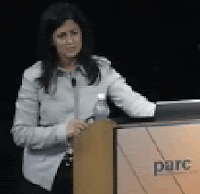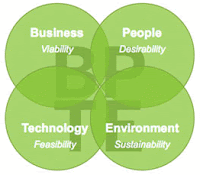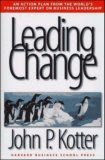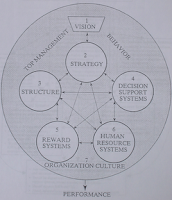The title of a BusinessWeek article by Roger Martin, Dean of the Rotman School of Management at the University of Toronto, nicely describes what this can feel like: "Designing in Hostile Territory."
In that article and in other articles, Roger does a great job of explaining why business is so hostile to design, and why that needs to change.
 Roger spoke about aspects of this at the recent CONNECTING 07 World Design Congress in San Francisco. Jon Kolko and I refer to some of what he said at that conference in "interactions cafe," an article to appear next month that presents some of our thoughts about the relationship between that conference (which we both attended) and contents of our first issue of interactions magazine. Here I extend that reflection, with a focus on Roger and his articles, on just one of the authors of content to appear in the January+February 2008 issue of interactions, and on a reference to some important related work.
Roger spoke about aspects of this at the recent CONNECTING 07 World Design Congress in San Francisco. Jon Kolko and I refer to some of what he said at that conference in "interactions cafe," an article to appear next month that presents some of our thoughts about the relationship between that conference (which we both attended) and contents of our first issue of interactions magazine. Here I extend that reflection, with a focus on Roger and his articles, on just one of the authors of content to appear in the January+February 2008 issue of interactions, and on a reference to some important related work. As reflected in the nearby blurry image of a slide from Roger's plenary presentation, there is little overlap between the kind of thinking that comprises design -- involving "consideration of a wide array of relevant variables, most of which are qualitative, to produce meaningful, valid solutions" -- and the kind of thinking that is dominant in business -- involving "reducing the number of variables considered to mostly quantitative measures in order to achieve consistency and predictability." To analytical thinkers, the activities and language of design thinking "connote danger, uncertainty, and guesswork." Little surprise that user experience personnel experience frustration in their workplaces.
As reflected in the nearby blurry image of a slide from Roger's plenary presentation, there is little overlap between the kind of thinking that comprises design -- involving "consideration of a wide array of relevant variables, most of which are qualitative, to produce meaningful, valid solutions" -- and the kind of thinking that is dominant in business -- involving "reducing the number of variables considered to mostly quantitative measures in order to achieve consistency and predictability." To analytical thinkers, the activities and language of design thinking "connote danger, uncertainty, and guesswork." Little surprise that user experience personnel experience frustration in their workplaces."Both (design thinking and analytical thinking) have their place, but as organizations grow, analytical thinking -- which focuses on exploitation and refinement of the current state of knowledge -- often crowds out design thinking -- which pushes knowledge forward and creates new possibilities. As a consequence, as businesses grow and tilt towards analytical thinking, they leave themselves exposed to competitors -- often smaller ones -- that use design thinking to outflank them."
 Compare those words from Roger with what Secil Watson, Senior VP Internet Channel Strategy at Wells Fargo, says about customer experience in our first issue of interactions magazine:
Compare those words from Roger with what Secil Watson, Senior VP Internet Channel Strategy at Wells Fargo, says about customer experience in our first issue of interactions magazine:"It is really hard for established companies and industry leaders to change their practices and business models to focus steadfastly on better customer experiences. They have so much invested in their current infrastructure that dramatic changes are very complex and time consuming in nature. But unless they change, this will create opportunities for new entrants that will develop their business models and infrastructure from scratch around a strategy that focuses on customer experience as an essential way to attain long-term customer value, as opposed to strategies that focus on marketing prowess, sales effectiveness, market share, distribution network, high switching costs, or cost efficiency."As Roger Martin argues, it is essential to create a business environment in which design thinking can flourish. However, as he states in "At the Crossroads of Design and Business":
"...if Design Thinking is critical, maybe restricting it to designers and protecting them from business people is not actually the most productive avenue to pursue. Perhaps eliminating the need for protection by turning business people into Design Thinkers would be more effective.And user experience personnel can play a critical role in creating this environment. Consider more words from Secil's interactions article on what it has taken to affect such change at Wells Fargo:
To create a Design Thinking organization, a company must create a corporate environment in which it is the job of all managers to understand customer needs at a deep and sophisticated level and to understand what the firm's product means to the customer at not only a functional level, but also an emotional and psychological level. It must also create a culture in which line managers are not satisfied with merely serving customers, but insist on delighting them and making them feel the company is their partner, friend, and confidante."
"We championed customer experience broadly. We knew that product managers, engineers, and servicing staff were equally important partners in the success of each of our customer-experience efforts. Instead of owning and controlling the goal of creating positive customer experience, we shared our vision and our methods across the group. This was a grassroots effort that took a long time. We didn’t do formal training across the group, nor did we mandate a new process. Instead, we created converts in every project we touched using our UCD methods. Having a flexible set of well-designed, easy-to-use UCD tools such as those mentioned (in this article) made the experience teams more credible and put us in the position of guiding the process of concept definition and design for our business partners."Claudia Kotchka, VP of Design Innovation & Strategy, has been responsible for achieving change of this nature at P&G. During a presentation at Stanford University this past spring, she described the P&G journey to achieve such change as progressing through three phases. Phase 1, "Discipline of Design," was a phase during which design was focused largely on aesthetics as other disciplines tried to figure out what to do with designers that were added to the organization. Phase 2, "Practice of Design," was a phase during which designers realized they couldn't achieve success effectively alone and needed to collaborate with people in other disciplines; among steps taken to help achieve this collaboration: a "mentoring up program" to enable managers to "see what designers see," and an effort to teach designers the language of business. Phase 3, "Design Strategy," moved on to infusing design innovation into business strategy via, in part, teaching design thinking to business leaders.
Neither Claudia nor Secil would claim that their work is done. But both have made great strides in changing the cultures of their workplaces.
Which phase is your company in? What kind of thinking dominates where you work? What roles are your user experience personnel playing? Are they still just "designing in hostile territory"?
---
Take the time to read some of Roger Martin's many terrific articles. Others I recommend include, "Reliability vs. Validity," "Scientific Management is Past it's Peak," and "Why Decisions Need Design."
In several past blog entries of mine, you can read more from Secil Watson and about the work she has been spearheading at Wells Fargo. See, for example, "Breaking silos," "Moving UX into a position of corporate influence: Whose advice really works?", and "Developing user-centered tools for strategic business planning."
"interactions cafe" will appear at the end of each issue of interactions magazine beginning with the January+February 2008 issue.


































